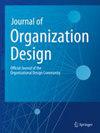设计包容性的组织身份
IF 2.1
Q3 BUSINESS
引用次数: 0
摘要
组织身份可以成为设计师追求建立组织的关键工具,这些组织雇用来自不同社会群体的个人,并创造包容性的工作场所文化,支持所有成员的归属感,无论他们在社会中的地位如何。我们将包容性组织认同定义为一种信念(由内部或外部利益相关者持有),即包容性是组织的定义特征之一;组织有意地将不同的个人——包括那些历史上被边缘化的社会身份——纳入其治理、运营和产出中。基于不同文献的研究——从微观层面的归属心理学研究,中观层面的感官赋予研究,以及宏观层面的受众如何感知组织的研究——我们开发了一种基于设计的组织认同研究方法。为了创造包容性的身份,设计师需要权衡是否要提出身份主张,将包容性作为一种身份特征,并与包容性的意识形态(同化与多元文化主义)相关联。如果他们选择提出身份要求,设计师可以通过培养管理者作为组织身份的管家,促进员工参与定义包容性,以及在多样性、公平、包容和归属(DEIB)方面保持透明来支持这些要求。本文章由计算机程序翻译,如有差异,请以英文原文为准。
Designing inclusive organizational identities
Abstract Organizational identity can be a key instrument in designers’ pursuit to build organizations that employ individuals from diverse social groups and create inclusive workplace cultures that support all members’ belonging, regardless of their status in society. We define an inclusive organizational identity as the belief (held by internal or external stakeholders) that inclusivity is one of the defining characteristics of an organization; that the organization intentionally incorporates diverse individuals—including those with historically marginalized social identities—into its governance, operations, and outputs. Building on studies in different literatures—ranging from micro-level research in psychology of belonging, meso-level research on sensegiving, and macro-level research on how organizations are perceived by their audiences—we develop a design-based approach to organizational identity. In order to create inclusive identities, designers will need to address trade-offs around whether to make identity claims, claim inclusivity as an identity feature, and affiliate with ideologies of inclusion (assimilation versus multiculturalism). If they choose to make identity claims, designers can bolster those claims by developing managers as stewards of the organization’s identity, facilitating employee participation to define inclusivity, and being transparent about diversity, equity, inclusion, and belonging (DEIB) efforts.
求助全文
通过发布文献求助,成功后即可免费获取论文全文。
去求助
来源期刊

Journal of Organization Design
Business, Management and Accounting-Strategy and Management
CiteScore
3.50
自引率
0.00%
发文量
22
期刊介绍:
The Journal of Organization Design is the intellectual home of organization design thinking. Drawing on a wide variety of disciplines, organization design analyzes how organizations work, and how they can work better, focusing on the choices about structures, systems, and processes that drive various organizational outcomes.
The journal advances understanding of topics important to academic researchers and industry professionals alike. We aim to publish novel research and commentary on known or emerging organization design concepts and phenomena; examine new technologies for the design and management of organizations; derive practical implications from existing studies; and analyze new and unusual forms of organizing.
We welcome high-quality submissions that expand on the foundations of organization design and uncover new phenomena. Uniquely, authors can choose from numerous article formats, providing customized vehicles for expression. Articles are peer-reviewed, written, and read not only by design scholars, but also by managers within organizations.
 求助内容:
求助内容: 应助结果提醒方式:
应助结果提醒方式:


